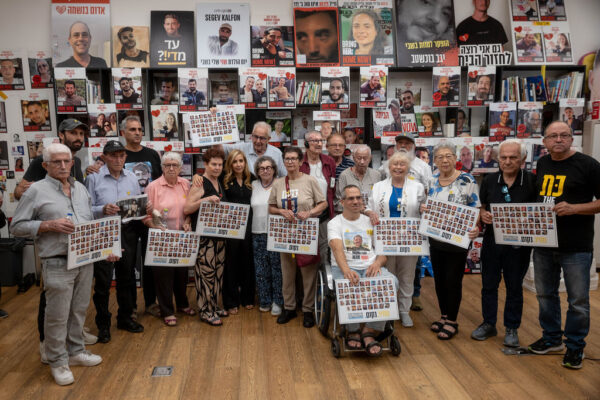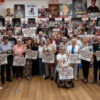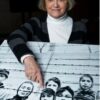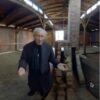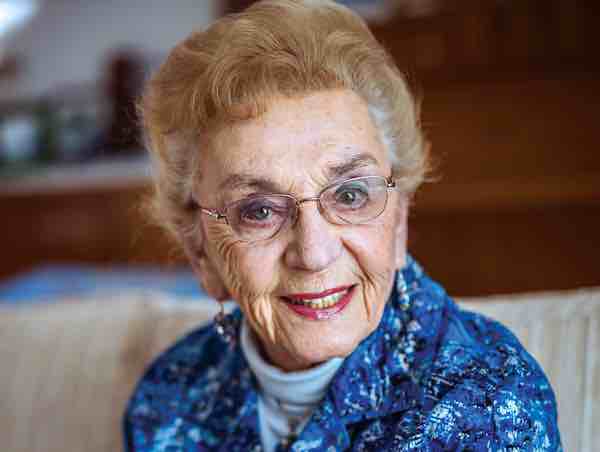
JewishJournal – “Get in rows. March,” the block leader ordered the nearly 300 women in the Auschwitz barracks who had arrived from the Plaszow concentration camp only weeks earlier, in mid-October 1944.
Thirteen-year-old Celina Karp dutifully obeyed, though this was the first time in Auschwitz that she had been separated from her mother, who earlier that morning had volunteered to peel potatoes, along with 29 others, hoping to pilfer a few skins.
Celina and the others were marched to another barracks, where they were ordered to strip and form a single line. Dr. Josef Mengele stood facing them, pointing with a yellow pencil in one direction or another as each prisoner drew near. Most were shunted to his left, rapidly exiting the barracks. Celina was directed to his right, frightened to find herself on the wrong side. Then unexpectedly, Mengele ordered Celina’s group to repeat the inspection. This time, as Celina approached Mengele — “I don’t know what made me do it,” she recalled — she looked up at him and said, “Lassen sie mich.” (“Let me go.”)
He pointed to his left. She grabbed her dress and ran out, crying hysterically. “I’m 13 years old and I’ve just been given life by Dr. Mengele,” she recalled.
That was just one of the twists that allowed Celina to survive. Perhaps more famously, Celina is alive today, at age 85, because of the actions of Oskar Schindler, the Czech businessman memorialized in Steven Spielberg’s 1993 film “Schindler’s List.” She is the youngest of the roughly 1,200 Jews Schindler rescued.
But she credits Spielberg, who brought to the screen so many of the horrendous incidents that she witnessed, with enabling her to speak about those experiences.
“I always tell Steven Spielberg that he gave me a voice,” she said. “I say, ‘You are my second Schindler. He gave me life, but you gave me a voice. Because for 40 years, I never was able to talk about it because I didn’t think that anybody would understand.’ ”
Celina Biniaz, since her marriage in 1953, was born in Krakow, Poland, on May 28, 1931, the only child of Ignac and Felicia Karp.
Both parents were accountants, and the family was comfortably middle class, living in a mixed neighborhood in a two-room apartment with a kitchen and bathroom. They celebrated Jewish holidays but were not strictly Orthodox.
After Germany attacked Poland on Sept. 1, 1939, Celina’s parents decided that she would have to relinquish her beloved puppy, a white Spitz. Several days later, as they took the dog to the animal shelter, they saw from a distance three bombs fall on the radio station — the beginning of the Nazi occupation of Krakow — and ducked into a nearby building. They then continued to the shelter, where Celina painfully surrendered her dog.
Celina was eager to enter third grade, but schools didn’t open that fall. Additionally, Jews couldn’t work, and Ignac joined the many Jewish men who began walking eastward, fearing capture by the Germans. But as winter approached, he returned.
By that time, the Jews were being conscripted into slave labor. Celina and her parents worked, shoveling snow.
By late fall 1940, the Karp family, along with most of Krakow’s Jews, had been relocated to a ghetto in the city’s Podgorze section. Celina’s parents, who were given blue cards, or work permits, were assigned to work at a factory outside the ghetto that was owned by Julius Madritsch.
Madritsch, a 34-year-old businessman and anti-Nazi from Vienna, had been named administrator of the F.A. Hogo shirt factory in Krakow, which he relocated to Podgorze and converted to sewing army uniforms. Ignac, who had been an accountant for F.A. Hogo, became Madritsch’s accountant, helping him manage the business. Felicia worked as a bookkeeper.
Celina, meanwhile, worked in the ghetto, making envelopes and brushes. But as roundups increased, Celina’s parents, worried she would be apprehended, procured a blue card for her, falsifying her age as 12, two years older than she was. Celina joined her parents at the factory, sewing uniforms.
“[Madritsch] was an amazing human being,” Celina said. He and Raimund Titsch, his factory manager, hired as many Jewish workers as possible, training them and providing them with extra food and medications.
When the Krakow ghetto was liquidated on March 13 and 14, 1943, those working in the Madritsch factory, who were essential to the war effort, were transferred to Plaszow, which was then a labor camp, rather than deported to a concentration camp.
During the liquidation, Celina witnessed German soldiers swinging infants by the feet, bashing their heads against stone walls. “I kept asking my mother, ‘How could God allow this?’ ” she said. “I lost my faith.” The experience also reinforced her fear of authority, which has never left her.
In Plaszow, Celina and her mother lived in a women’s barracks, walking to and from the factory daily in groups of five. She often saw her father there.
Inside the camp, however, where Amon Goeth was the commandant, fear ruled. “He was a beast,” Celina said. She witnessed hangings, shootings and beatings.
During one of the selections, Celina watched as the Germans rounded up 10 or 15 children. They then trucked them up a hillside and shot them, while the German lullaby “Gute Nacht, Mutter” (“Good Night, Mother”) played on the camp loudspeakers. “So sadistic,” Celina said. “You can’t imagine.”
During that time, six children managed to hide in the latrines. Madritsch’s workers later smuggled them out to the factory under big coats, two with Celina’s group, and they were placed with Catholic families.
In September 1943, a new edict forbade prisoners from leaving Plaszow’s confines. In response, Madritsch opened a factory inside the camp.
A year later, as the Russians approached, the Germans ordered all factories in the Krakow area closed. Schindler suggested that Madritsch, who had become his friend, join him in relocating his factory to Czechoslovakia. Madritsch declined, but sent 50 or more of his workers, including Celina and her parents, with Schindler’s group.
The men were shipped out first. Two weeks later, the 300 women were loaded into cattle cars. A day and a half later, in mid-October 1944, the train came to a screeching halt. As the door banged open, the women heard, “Raus, raus” (“out, out”) and dogs barking. “All of a sudden, we realized we’re someplace we’re not supposed to be,” Celina said. “Auschwitz.”
The women were marched into a barracks marked “sauna” (bath) and told to strip. Celina’s hair was clipped very short, others were shaved, and all were shoved into the shower room. “This is when we don’t know … is it going to be water or gas?” Celina said. She was incredulous when water burst from the showerheads. “That meant we had another day.”
The women were given dresses and taken to a barracks. Mostly they remained inside, except for the three times a day they stood in roll call, often for hours in the cold.
A few weeks after Celina’s run-in with Mengele, the women were unexpectedly loaded into cattle cars, pulling into the town of Brunnlitz, 140 miles northeast of Prague, three days later. Schindler had secured their release with bribes.
The women slept in the attic of the factory, where components of V2 rockets were manufactured. “Schindler told us from the very beginning that nothing was going to leave that factory that would be useable,” Celina said. With her small hands, she was put to work cleaning the insides of the large machinery. She also worked on a lathe and a calibrating machine.
On May 7, 1945, Germany surrendered. Schindler escaped, but not before giving each family two bolts of fabric and five pairs of scissors to use as barter.
Two days later, the Soviets officially liberated the prisoners, and Celina and her parents walked and hitchhiked back to Krakow, a two-week journey. Celina was almost 14. She weighed 70 pounds.
Celina spent the summer being tutored and was accepted into high school in September. But four weeks later, a pogrom hit eastern Poland, and the Karps fled.
They were smuggled over the border into Slovakia and eventually reached the displaced persons camp in Landsberg, Germany. But after two weeks, having had enough camp life, they moved to Mindelheim, a small community about 20 miles east, where they shared an attic apartment with the widow of a Nazi.
Celina attended school in a semi-cloistered convent where an elderly nun, Mater Leontina, 90, taught her German and English. “She was the first human being who accepted me for who I was, a 14-year-old girl who needed help,” she said. Celina studied with her from December 1945 until May 1947, when she left for the U.S., and the two continued to correspond until Mater Leontina’s death at age 94.
Ignac’s brother, David Karp, who had sent affidavits for the family, met them when their ship docked in New York in June 1947 and drove them to Des Moines, Iowa, where he lived. Celina attended summer school, entering North High School for her senior year.
She attended Grinnell College, majoring in philosophy, and then Columbia University in New York, where she earned a master’s degree in education and where, in the international dormitory, she met Amir Biniaz. They married on Sept. 12, 1953, and moved to Wantagh, a town on Long Island, where Amir opened a dental practice.
In 1963, when their children — Robert was born in 1954, Susan in 1958 — were older, Celina began teaching elementary and learning disabled students. She retired in 1992. A year later, they moved to Camarillo, Calif. They now have four grandchildren.
The Holocaust taught Celina that “Evil can happen anywhere, with any human being, if you give it a chance.” But when Celina speaks about her experiences, which she has done since becoming active in the USC Shoah Foundation when it opened in 1994, she tells people:
“Don’t hate. Try to see the good in people. Nobody is better than anyone else.”
Originally published HERE
